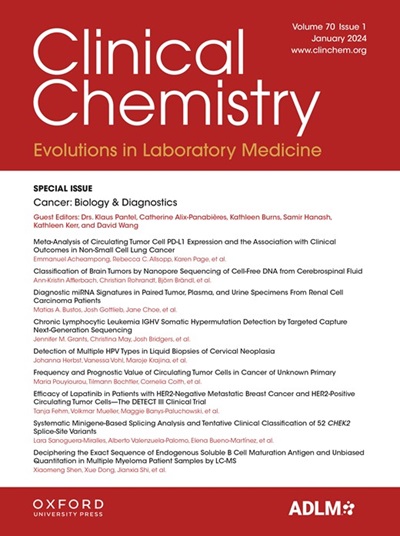B-168 Development and Validation of a Quantitative Ultra-Performance Liquid Chromatography Quadrupole Time-of-Flight (UPLC-QToF) Method for Urine Organic Acid Analysis
IF 6.3
2区 医学
Q1 MEDICAL LABORATORY TECHNOLOGY
引用次数: 0
Abstract
Background Urine organic acid (UOA) analysis is essential for the diagnosis of inborn errors of metabolism (IEMs). Traditionally, UOA analysis is performed with gas chromatography-mass spectrometry (GC-MS) and requires time-consuming sample preparation steps including liquid-liquid extraction and derivatization. The rapid development of Ultra-Performance Liquid Chromatography Tandem Mass Spectrometry (UPLC-MS/MS) in the past few years provides the opportunity to perform UOA analysis with a dilute-and-shoot methodology. We describe the development and validation of a quantitative Ultra-Performance Liquid Chromatography Quadrupole Time-of-Flight (UPLC-QToF) method for UOA analysis. Methods Urine specimens were diluted to normalize creatinine concentrations to 1 mmol/L. 20 µL of urine specimen (diluted), calibrator, or quality control (QC) material was mixed with 400 µL of mobile phase A (0.05% formic acid in water) and a mixture of isotope-labeled internal standards. After centrifugation, 10 µL of the supernatant was analyzed using a Xevo G3 QTOF mass spectrometer (Waters) with a ACQUITYTM Premier HSS T3 1.8 µm VanGuardTM FIT 2.1 x 150 mm column (Waters). Data collection was performed with negative electrospray ionization (ESI) mode using the MSE method to produce fragment ions when applicable. Repeatability, reproducibility, and carryover were assessed using the QC materials. The analytical measuring range (AMR) was assessed using synthetic urine spiked with increasing concentrations of each organic acid. Accuracy was assessed by method comparison with the UOA test performed at Mayo Clinic Laboratory and by spike-recovery study using a pooled urine specimen. Matrix effect was also evaluated with matrix dilution study. Results An optimized LC method was used to enable high-resolution separation of selected UOAs (N = 29) and isomers. Total analytical time was 20 min per injection. Both linear and quadratic regressions were used to build the calibration curves. AMR and correlation coefficients of a few representative UOAs were: orotic acid (3.4 to 214.2 mmol/mol creatinine, R^2 = 0.99, linear regression); 2-methylcitric acid (4 to 189 mmol/mol creatinine, R^2 = 0.99, linear regression); 3-methylcrotonylglycine (0.3 to 18.0 mmol/mol creatinine, R^2 = 0.99, linear regression). Repeatability and reproducibility were mostly <=10% CV and no carryover was observed. Spike-recovery study demonstrated recoveries between 80% and 120%, and method comparison study demonstrated no discrepancies with results from Mayo Clinic Laboratory. Conclusions We have developed and validated a novel UPLC-QTOF method for UOA analysis to support the diagnosis of IEMs with acceptable analytical and clinical performances. Compared with the traditional GC-MS method, the UPLC-QTOF method requires a very small specimen volume and does not require laborious and time-consuming sample preparation steps. Continued optimization of the method will be pursued to measure more UOAs to support the diagnosis of more IEMs.B-168 用于尿液有机酸分析的超高效液相色谱四极杆飞行时间 (UPLC-QToF) 定量方法的开发与验证
背景尿液有机酸(UOA)分析是诊断先天性代谢错误(IEM)的关键。传统上,UOA 分析采用气相色谱-质谱法(GC-MS),需要耗时的样品制备步骤,包括液液萃取和衍生化。过去几年中,超高效液相色谱-串联质谱法(UPLC-MS/MS)的快速发展为采用稀释-拍摄方法进行 UOA 分析提供了机会。我们介绍了用于 UOA 分析的超高效液相色谱四极杆飞行时间(UPLC-QToF)定量方法的开发和验证。方法 将尿液标本稀释,使肌酐浓度正常化至 1 mmol/L。将 20 µL 尿液标本(稀释)、校准物或质量控制(QC)材料与 400 µL 流动相 A(0.05% 甲酸水溶液)和同位素标记内标混合物混合。离心后,使用 Xevo G3 QTOF 质谱仪(Waters)分析 10 µL 上清液,该质谱仪配有 ACQUITYTM Premier HSS T3 1.8 µm VanGuardTM FIT 2.1 x 150 mm 色谱柱(Waters)。数据收集采用负电喷雾电离 (ESI) 模式,在适当情况下使用 MSE 方法产生碎片离子。使用质控材料评估了重复性、再现性和携带率。使用添加了浓度不断增加的各种有机酸的合成尿液对分析测量范围(AMR)进行了评估。通过与梅奥诊所实验室进行的 UOA 检测进行方法比较,并使用尿液标本进行加标回收研究,对准确性进行了评估。基质稀释研究也评估了基质效应。结果 采用优化的液相色谱法对选定的 UOA(N = 29)和异构体进行了高分辨分离。每次进样的总分析时间为 20 分钟。线性回归和二次回归均用于建立校准曲线。具有代表性的几种 UOAs 的 AMR 和相关系数分别为:乳清酸(3.4 至 214.2 毫摩尔/摩尔肌酐,R^2 = 0.99,线性回归);2-甲基柠檬酸(4 至 189 毫摩尔/摩尔肌酐,R^2 = 0.99,线性回归);3-甲基巴豆酰甘氨酸(0.3 至 18.0 毫摩尔/摩尔肌酐,R^2 = 0.99,线性回归)。重复性和再现性大多为 <=10% CV,未观察到携带现象。尖峰回收率研究表明回收率在 80% 到 120% 之间,方法对比研究表明与梅奥诊所实验室的结果无差异。结论 我们开发并验证了一种用于 UOA 分析的新型 UPLC-QTOF 方法,该方法具有可接受的分析和临床表现,可用于 IEMs 的诊断。与传统的气相色谱-质谱(GC-MS)方法相比,UPLC-QTOF 方法所需的样品量非常小,而且不需要费时费力的样品制备步骤。我们将继续优化该方法,以测定更多的UOAs,为更多的IEM诊断提供支持。
本文章由计算机程序翻译,如有差异,请以英文原文为准。
求助全文
约1分钟内获得全文
求助全文
来源期刊

Clinical chemistry
医学-医学实验技术
CiteScore
11.30
自引率
4.30%
发文量
212
审稿时长
1.7 months
期刊介绍:
Clinical Chemistry is a peer-reviewed scientific journal that is the premier publication for the science and practice of clinical laboratory medicine. It was established in 1955 and is associated with the Association for Diagnostics & Laboratory Medicine (ADLM).
The journal focuses on laboratory diagnosis and management of patients, and has expanded to include other clinical laboratory disciplines such as genomics, hematology, microbiology, and toxicology. It also publishes articles relevant to clinical specialties including cardiology, endocrinology, gastroenterology, genetics, immunology, infectious diseases, maternal-fetal medicine, neurology, nutrition, oncology, and pediatrics.
In addition to original research, editorials, and reviews, Clinical Chemistry features recurring sections such as clinical case studies, perspectives, podcasts, and Q&A articles. It has the highest impact factor among journals of clinical chemistry, laboratory medicine, pathology, analytical chemistry, transfusion medicine, and clinical microbiology.
The journal is indexed in databases such as MEDLINE and Web of Science.
 求助内容:
求助内容: 应助结果提醒方式:
应助结果提醒方式:


